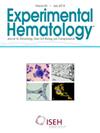C-COUNT: a convolutional neural network–based tool for automated scoring of erythroid colonies
IF 2.1
4区 医学
Q2 HEMATOLOGY
引用次数: 0
Abstract
Despite advances in flow cytometry and single-cell transcriptomics, colony-formation assays (CFAs) remain an essential component in the evaluation of erythroid and hematopoietic progenitors. These assays provide functional information on progenitor differentiation and proliferative potential, making them a mainstay of hematology research and clinical diagnosis. However, the utility of CFAs is limited by the time-consuming and error-prone manual counting of colonies, which is also prone to bias and inconsistency. Here we present “C-COUNT,” a convolutional neural network–based tool that scores the standard colony-forming-unit-erythroid (CFU-e) assay by reliably identifying CFU-e colonies from images collected by automated microscopy and outputs both their number and size. We tested the performance of C-COUNT against three experienced scientists and find that it is equivalent or better in reliably identifying CFU-e colonies on plates that also contain myeloid colonies and other cell aggregates. We further evaluated its performance in the response of CFU-e progenitors to increasing erythropoietin concentrations and to a spectrum of genotoxic agents. We provide the C-COUNT code, a Docker image, a trained model, and training data set to facilitate its download, usage, and model refinement in other laboratories. The C-COUNT tool transforms the traditional CFU-e CFA into a rigorous and efficient assay with potential applications in high-throughput screens for novel erythropoietic factors and therapeutic agents.
C-COUNT:一种基于卷积神经网络的红系克隆自动评分工具。
尽管流式细胞术和单细胞转录组学取得了进展,但集落形成分析仍然是评估红细胞和造血祖细胞的重要组成部分。这些检测提供了祖细胞分化和增殖潜力的功能信息,使其成为血液学研究和临床诊断的支柱。然而,菌落形成测定的效用受到耗时和容易出错的人工菌落计数的限制,这也容易产生偏差和不一致。在这里,我们提出了“C-COUNT”,这是一种基于卷积神经网络的工具,通过可靠地从自动显微镜收集的图像中识别CFU-e菌落,对标准CFU-e检测进行评分,并输出它们的数量和大小。我们与三位经验丰富的科学家测试了C-COUNT的性能,发现它在可靠地识别含有髓系菌落和其他细胞聚集体的板上的CFU-e菌落方面是相同或更好的。我们进一步评估了其在CFU-e祖细胞对增加的促红细胞生成素浓度和一系列遗传毒性药物的反应中的表现。我们提供了C-COUNT代码、Docker图像、训练模型和训练数据集,以方便其他实验室下载、使用和模型改进。C-COUNT工具将传统的CFU-e集落形成分析转变为一种严格高效的分析方法,在新型红细胞生成因子和治疗剂的高通量筛选中具有潜在的应用前景。
本文章由计算机程序翻译,如有差异,请以英文原文为准。
求助全文
约1分钟内获得全文
求助全文
来源期刊

Experimental hematology
医学-血液学
CiteScore
5.30
自引率
0.00%
发文量
84
审稿时长
58 days
期刊介绍:
Experimental Hematology publishes new findings, methodologies, reviews and perspectives in all areas of hematology and immune cell formation on a monthly basis that may include Special Issues on particular topics of current interest. The overall goal is to report new insights into how normal blood cells are produced, how their production is normally regulated, mechanisms that contribute to hematological diseases and new approaches to their treatment. Specific topics may include relevant developmental and aging processes, stem cell biology, analyses of intrinsic and extrinsic regulatory mechanisms, in vitro behavior of primary cells, clonal tracking, molecular and omics analyses, metabolism, epigenetics, bioengineering approaches, studies in model organisms, novel clinical observations, transplantation biology and new therapeutic avenues.
 求助内容:
求助内容: 应助结果提醒方式:
应助结果提醒方式:


